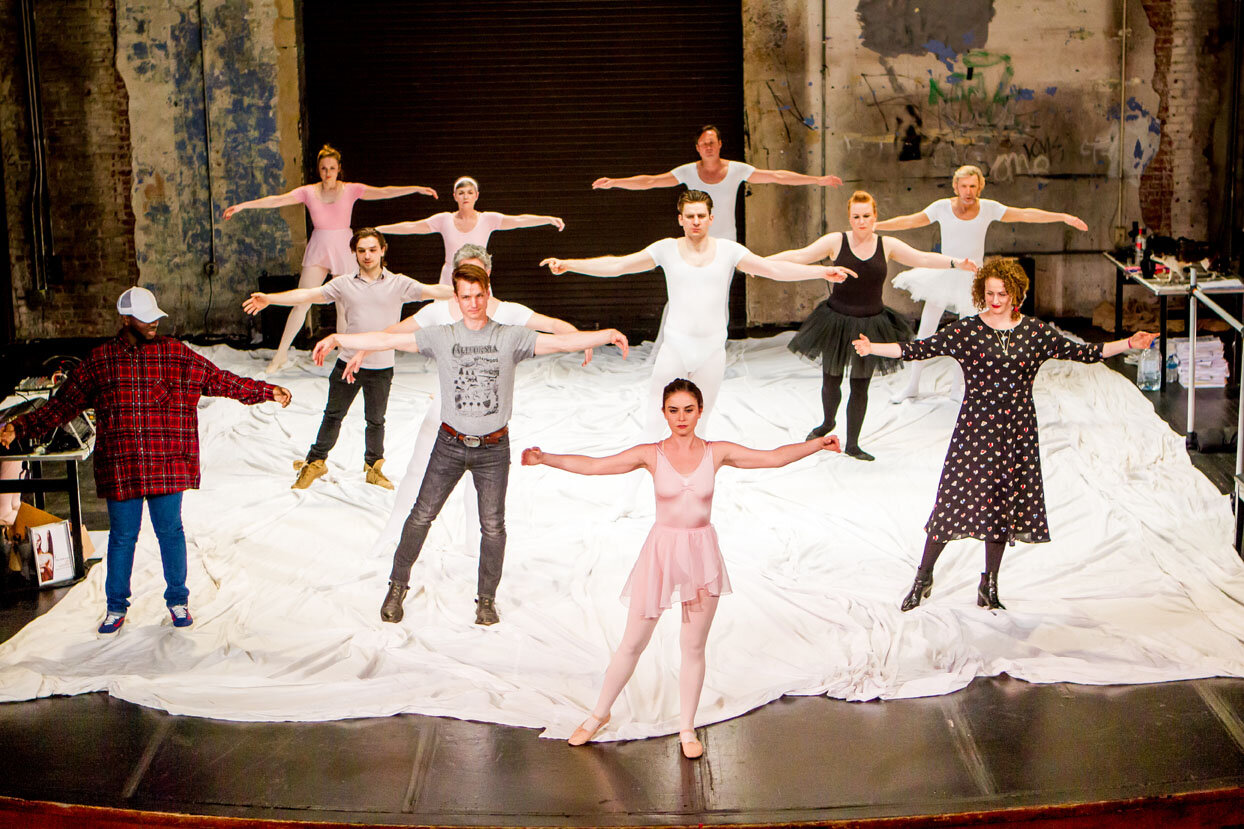THE SEAGULL AND OTHER BIRDS

Gothenburg Dans O Theater Festival, Gothenburg, Sweden 22 - 23 August 2016 | San Francisco International Arts Festival, San Francisco, U.S.A. 25 - 28 May 2016 | Abrons Arts Center, New York, U.S.A. 23 March - 2 April 2016
Noordezan Performing Arts Festival, Groningen, The Netherlands, 21 - 24 August 2015
Forum Freies Theater, Düsseldorf, Germany 13 - 15 November 2014 | Dublin Theatre Festival, Project Arts Centre 25 September - 5 October 2014
‘Whatever you may wind up thinking of the creators… you will definitely want to eat your next meal with them.’
Time Out
“What we need are new artistic forms. And if we don’t get new forms it would be better if we had nothing at all.”
(Konstantin, The Seagull, 63)
The Seagull by Anton Chekhov takes place in 19th century Russia, featuring dissatisfied characters: some long for an unrequited love and some for unfulfilled desires such as success or artistic greatness. Central to the plot is the relationship between the famous actor, Arkadina, and her tormented, aspiring writer son, Konstantin, which is far from being ideal. Arkadina’s lover, Trigorin, a famous and established writer, aggravates Konstantin’s Oedipal complex, especially when his love interest, Nina, falls in love with Trigorin. At the same time, Masha, the estate manager’s daughter is in turn in love with Konstantin and Medvedenko, a poor schoolteacher, with Masha.
Sorin, Arkadina’s brother and the estate’s owner, is also a man of failed ambitions that tries to reconcile the discrepancies between his sister and nephew. To no avail.
Gavin Quinn defines Americanitis as a frame to create an aesthetic onstage: work that is simple, precise and open to possibilities. Within this conceptual aim, The Seagull operates as a dramaturgical spine that allows for an investigation of form and content, in line with Chekhov’s own experimentations with the dramatic conventions of the time. Effectively, The Seagull marks a new phase in the playwright’s career towards a theatre of indirect action in which conflict does not result in confrontation: there is no climax, no resolution and no character exposition. Chekhov plays are not plot driven and some have compared them to the studies artists undertake when preparing a painting. This way Chekhov portrays a mood that emphasises the unspoken by making it palpable through an atmosphere; this underlines our failure to communicate with each other through language, and at the same time interrogates the means of theatrical language, especially through symbolism. Thus, The Seagull enables that simplicity, precision and possibility Americanitis seeks.
Thomas G. Winner argues that Chekhov used Hamlet as a contrasting dramatic device to The Seagull. Similarly, Pan Pan’s response uses The Seagull as a device to expand and explore its main themes and strategies. For instance, the original’s intertextual use of Hamlet in the opening scene reveals aspects of the relationship between Arkadina and Konstantin. Pan Pan’s production expands Chekhov’s intertextual strategy through a series of especially commissioned texts. This way, the characters and their relationships are explored through these diverse (con)texts. Thus, if for Michael Frayn the lack of an authorial voice in Chekhov’s plays, or what he calls “his elusiveness”, forces us not to see “Chekhov’s world but the world of his characters” (xiii), Pan Pan’s own “elusive” response makes us see these characters in different worlds, scenarios and situations. This approach was paralleled during the creative process by exploring the project in China for seven weeks. The Chinese version with a Chinese cast played in August and September at the 8 O’Clock Space in Chengdu and in Beijing at the National Centre for the Performing Arts.
At the same time, Americanitis’ overall formalistic investigation reinforces The Seagull‘s self-reflexivity, which, fundamentally, serves the purpose of discussing the nature of art and the need for new forms. This is represented by Konstantin’s character and his artistic struggle as a writer trying to create something innovative. It is perhaps auspicious that Stanislavski’s acclaimed production of The Seagull for the Moscow Art Theatre in 1898 featured the revolutionary Vsevolod Meyerhold playing Konstantin. On the other hand, Trigorin, represents old forms. The tensions between both characters, beyond Konstantin’s (justified) jealousy, must be also contemplated within this context and beyond his Oedipal issues reminiscent of Hamlet. Quinn stretches this self-reflexivity, enhancing the meta-theatrical strategies of The Seagull, through the different commissioned texts that act as “plays-within-the-play”. Or by having the actors –although in relational characterisation– calling each other by their real names.
Pan Pan’s particular exploration with form led the company to open the rehearsal process to audiences, who could pop in at will and sometimes were asked to participate. This opened new potentials in terms of exploring a different relationship with the audience, a key aspect of the company’s ethos who seeks to establish a specific connection with spectators. This openness to interrogation also translates in the show taking different avenues every night, that is, using different inter-texts (or rather, hyper-texts) following a system reminiscent of Merce Cunningham’s chance procedures. And, like Chekhov’s play, it’s open-ended. Thus, reinforcing the ephemeral nature of performance, a different experience is offered every night. I italicise the verb ‘offer’ because this is basically the proposal the company is making: an invitation to explore together the nature and possibilities of theatre, of character, of communication, and of what Paul Woodruff calls “the necessity of theatre: the art of watching and being watched”.
Noelia Ruiz
Works Cited
– Chekhov, Anton Pavlovich, and Michael Frayn. Plays. London: Methuen, 1988.
– Woodruff, Paul. The Necessity of Theater: The Art of Watching and Being Watched. Oxford: Oxford U, 2008
– Winner, Thomas G. “Chekhov’s Seagull and Shakespeare’s Hamlet: A Study of a Dramatic Device.” American Slavic and East European Review 15 (February 1956): 103-11
“This show also conveys the unquenchable energy that courses through the very attempt to make art, a vigor that bubbles to the surface at unexpected moments and in exhilarating ways. The manners with which the cast co-opts audience members into the proceedings should be embarrassing but instead feels jubilantly collegial.”
Ben Brantley, The New York Times
“You’ll find that what Pan Pan has done is to dig deeply into Chekov’s play, retaining its broad outline and filtering it through an Irish sensibility reminiscent of James Joyce or Samuel Beckett at their most enigmatic.”
Howard Miller, Talkin Broadway
“Every person in the cast is full of intense energy and director and co-founder Gavin Quinn channels that energy into a piece that bounces into every corner of the space to create a larger than life performance.”
Victoria Teague, New York Theatre Review
“… it does exactly what Quinn appears to be attempting: to inhabit Chekhov’s mind so intensely that it is not his writing but his purpose which is examined. It becomes the direct opposite of current preoccupations with de-construction: the result is not Pan Pan’s vision of Chekhov, or even director Quinn’s, but almost luminously Chekhov’s own. And it makes unarguably clear his own description of The Seagull as a comedy.”
Emer O’Kelly, Sunday Independent
“Although their work could be mistaken for banal ‘postmodern’ parody, Irish theatre company Pan Pan have a seriousness that resists the jaded flippancy that often passes for subversion. So, while their bizarre take on Chekhov’s classic The Seagull is playful, daft, and ‘meta’, it’s also thrumming with something visceral and enigmatic, the sad, perhaps pointless passion of the human.”
Padraig Killeen, Irish Examiner
“As usual, Pan Pan present us with a work that skewers and examines both the contemporary and the classic modes of theatre, but this time with a difference: There is a playfulness to Americanitis, a revelling in the ridiculous-ness of the theatrical experience that is infectious, regardless of your theatrical chops (or lack thereof). The Seagull and Other Birds is ambitious, bold, loud, incisive and interrogative”
Gillian Greer, Meg.ie
Other reviews:
Chris McCormack – Musings in Intermissions
Beccy Fitzpatrick – LeCool Dublin
Megan W. Minogue – The Public Reviews
Cast 2015/2016: Andrew Bennett, Una McKevitt, Gina Moxley, Daniel Reardon, Judith Roddy, Dick Walsh
Cast 2014: Andrew Bennett, Una McKevitt, Gina Moxley, Samantha Pearl, Daniel Reardon, Dick Walsh
Directed by: Gavin Quinn
Design: Aedín Cosgrove
Costumes: Grace O’Hara
Dramaturg: Simon Doyle
Assistant Director: Zoe Ni Riordáin (2014) / Maeve Stone (2015/2016)
Photos: Ros Kavanagh and Alex Escalante






